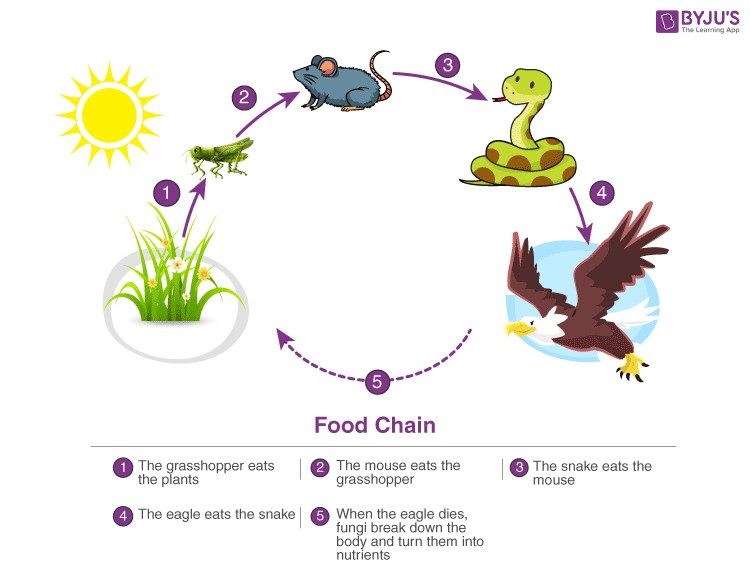A food chain illustrates the flow of energy and nutrients as one organism consumes another within an ecosystem. It’s a linear sequence that traces the path of these vital resources from producers to consumers and ultimately to decomposers. Understanding food chains reveals the intricate dependence of each organism on others for survival.
Let’s delve deeper into the various aspects of a food chain to gain a comprehensive understanding of this fundamental ecological concept.
Defining the Food Chain: A Transfer of Energy
A food chain describes the sequence of events in an ecosystem where organisms consume each other. A smaller organism becomes food for a larger one, demonstrating the transfer of nutrients and energy through different trophic levels. This feeding relationship is essential for maintaining the balance of the ecosystem.
Trophic levels represent the sequential stages in a food chain, starting with producers at the base, followed by primary, secondary, and tertiary consumers. Each level signifies a distinct feeding group.
A typical food chain consists of four essential components:
-
The Sun: The sun is the primary source of energy for almost all life on Earth, providing the initial energy input for the entire food chain.
-
Producers: Producers are autotrophic organisms, such as plants, algae, and cyanobacteria. They convert light energy from the sun into chemical energy through photosynthesis, creating their own food. Producers form the first trophic level and are the foundation of every food chain. They are also known as autotrophs as they make their own food.
-
Consumers: Consumers are heterotrophic organisms that obtain energy by feeding on other organisms. They are classified into different categories based on their diet:
- Herbivores: Primary consumers that eat producers (plants).
- Carnivores: Secondary and tertiary consumers that eat other animals.
- Omnivores: Consumers that eat both plants and animals.
- Parasites: Organisms that live on or in a host organism and obtain nutrients from it.
- Scavengers: Animals that consume dead animals’ carcasses.
Herbivores occupy the second trophic level, while carnivores can be found in the third, fourth, or even higher trophic levels, depending on their position in the food chain.
-
Decomposers: Decomposers, such as bacteria and fungi, break down dead organic matter and waste, releasing nutrients back into the environment. This process is crucial for recycling nutrients and making them available to producers, completing the cycle of energy and nutrient flow. Decomposers break down organic waste materials into inorganic materials, enriching the soil and oceans with nutrients.
Decomposers play a crucial role in nutrient recycling, providing essential elements to the soil and oceans that can be utilized by producers, thus initiating a new food chain.
Food Webs: Interconnected Food Chains
A food web is a more complex representation of feeding relationships in an ecosystem, consisting of multiple interconnected food chains. Unlike a simple food chain, a food web acknowledges that many organisms consume a variety of food sources and are consumed by multiple predators. This intricate network of interactions provides a more realistic depiction of energy flow within an ecosystem.
The complexity of a food web increases with the number of cross-interactions between different food chains. This complexity contributes to a more resilient and sustainable ecosystem, as it allows for alternative food sources and pathways in case of disruptions.
Types of Food Chains: Detritus and Grazing
Food chains can be broadly categorized into two main types:
- Detritus Food Chain: The detritus food chain begins with dead organic matter (detritus) and involves a community of decomposers and detritivores, including bacteria, fungi, protozoa, mites, insects, and worms. Detritivores consume the detritus, and are then consumed by smaller carnivores. These carnivores, such as maggots, may become food for larger carnivores like frogs or snakes. Primary consumers in this chain, such as fungi, bacteria, and protozoans, are detritivores that feed directly on the detritus.
- Grazing Food Chain: The grazing food chain starts with green plants (producers) and proceeds through herbivores and then carnivores. Energy in the lowest trophic level is derived from photosynthesis. The initial energy transfer in this type of food chain is from plants to herbivores. The majority of ecosystems on Earth follow this type of food chain, which depends on the flow of energy from autotrophs to herbivores.
Conclusion
Understanding food chains is essential for comprehending the intricate relationships within an ecosystem. They illustrate the flow of energy and nutrients and highlight the dependence of each organism on others for survival. Recognizing the role of each component of a food chain is crucial for maintaining ecological balance and ensuring the health of our planet.
